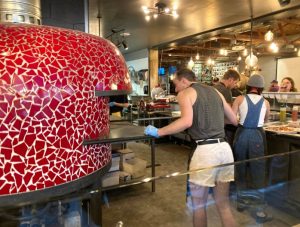Restaurateurs say they’ve been forced to raise prices because their food, rent and labor costs have continued to rise.
“People are paying more for their food than they ever have and they’re not happy about it,” said John Conley, owner of Salsa Brava and Fat Olives.
“It is the most challenging time ever,” said Conley, who started Salsa Brava 36 years ago when he left Northern Arizona University during his senior year.
Flagstaff’s hospitality industry has long depended on students, townies cross-country travelers and visits by desert dwellers to boost its revenue.
The mountain town’s 238 restaurants and bars reported combined annual sales of $233 million, which generated $9.98 million in tax revenue, according to a city-funded study by the NAU Economic Policy Institute. The restaurant sector employs nearly 3,000 workers in a city of 76,000 people.
Flagstaff’s 88 hotels, with1,073 workers, had combined sales of $126.7 million, generating $5.4 million in tax revenue.
In an effort to address economic challenges and boost Flagstaff’s foodie scene, a group of 20 restaurateurs has been meeting monthly for two years. The Bridgebuilders group includes Conley and Dara Wong, pastry chef and owner of Shift Kitchen & Bar. Kevin Heinonen and Lance Reynolds represent That Place Projects, which operates Tourist Home, Annex, Tinderbox and Teatro Italian Food & Wine.
The group’s collaborative effort is aimed at garnering support for Flagstaff’s hospitality industry and improving profits for the city’s restaurants, said Mark Christopher Molinaro, interim director of NAU’s Hotel and Restaurant Management School. He is also a group participant.
“I love where we’re heading,” he said. “I feel like we have an incredible diversity of restaurants. We have a thriving local restaurant scene. Plus, we have some of the larger and medium-sized [restaurant] brands that also attract tourism, because you kind of need both.”
Flagstaff’s top restaurants opened some eyes earlier this year when the James Beard Foundation honored Proper Meats + Provisons as a semifinalist for Outstanding Restaurant. It also selected Christian Lowe of Shift Kitchen as an Emerging Chef semifinalist. The James Beard awards are akin to the Oscars for restaurateurs.
Other honors include Fat Olives and Pizzicletta, which were recently named by The Washington Post as having the best Pizza in Flagstaff. The newspaper crunched the numbers on Yelp reviews to select the top regional pizza restaurants in each state.
Several years ago, Conley appeared on Guy Fieri’s Food Network show “Diners, Drive-Ins and Dives” to feature his Navajo taco. Conley also operates Stromboli’s and Old Town Creperie. He plans to open Fat Bagels in November to add to his Flagstaff eateries.
A recent study shows Arizona ranked fifth in U.S. states where residents enjoy dining out, based on restaurant-related online searches.
Price comparison experts at PriceListo.com compiled a list of how many people in each state searched for 3,500 dining-related terms. Colorado ranked first with nearly 75,000 monthly searches per 100,000 residents. Arizona had 67,194 searches each month.
Arizonans have not lost their interest in dining out, but operators say they’re getting sticker shock reading menu prices and choosing to treat themselves less in order to keep their dining checks in check.
“I worry that we’re going to lose more business as people’s wallets are getting pinched,” said John Kennelly, president of Kennelly Concepts. His company operates Historic Brewing Co., Station 66, an Italian restaurant, Frontier Restaurant, and other locations in Williams and Flagstaff.
Restaurateurs say they’ve been forced to raise prices because their food, rent and labor costs have continued to rise.
“We’re going to kill our industry for our independents,” Conley said.
Flagstaff’s minimum wage is $16.80 per hour and $14.80 for tipped employees. It will increase to $17.40 and $15.90 next year. Flagstaff voters approved the city’s minimum wage increases in 2016.
Arizona’s minimum wage of $13.85 will increase to $14.35 next year.
Kennelly, in business since 2007, added $150,000 to his annual payroll to pay workers the non-tipped minimum wage of $16.80. Plus, the tip pool is shared with servers, cooks and dishwashers.
Conley of Fat Olives and Salsa Brava said his food costs are up 9% and labor costs jumped 16%. In response, the veteran chef enacted a 4% service fee on customer’s bills. He said he was forced to do it because his profit margins are so thin, as low as 4%.
Conley has also ditched Door Dash and Uber Eats because his kitchens do not have the capacity to meet that demand.
But some things have not changed for restaurants and their workers, Conley said.
“We have to treat people like it’s their first time in and we have to earn that respect,” he said. “We can’t take anything for granted.” FBN
By Peter Corbett, FBN
Photo by Peter Corbett: A pizzamaker slides a pie in the oven at Pizzicleta’s pizzeria at Dark Sky Brewing.







